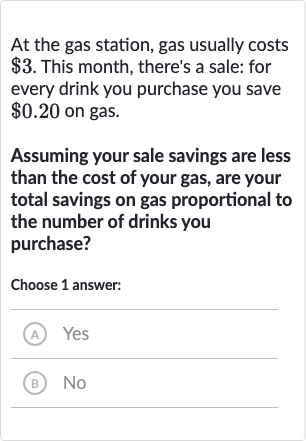AI tutor
Welcome to Bytelearn!
Let’s check out your problem:

At the gas station, gas usually costs . This month, there's a sale: for every drink you purchase you save on gas.Assuming your sale savings are less than the cost of your gas, are your total savings on gas proportional to the number of drinks you purchase?Choose answer:(A) Yes(B) No
Full solution
Q. At the gas station, gas usually costs . This month, there's a sale: for every drink you purchase you save on gas.Assuming your sale savings are less than the cost of your gas, are your total savings on gas proportional to the number of drinks you purchase?Choose answer:(A) Yes(B) No
- Understand Proportionality Definition: To determine if the savings on gas are proportional to the number of drinks purchased, we need to understand the definition of proportionality. Proportionality means that as one quantity increases, the other quantity increases at a constant rate. In this case, we are looking at the relationship between the number of drinks purchased and the savings on gas.
- Denote Variables and Calculate Total Savings: Let's denote the number of drinks purchased as and the savings on gas per drink as . The total savings on gas, , can be calculated by multiplying the number of drinks by the savings per drink: .
- Substitute Savings Per Drink Value: Given that the savings per drink is \(0\).\(20\), we can substitute \( s \) with . in the equation: .
- Total Savings Directly Proportional to Drinks: This equation shows that the total savings on gas, , is directly proportional to the number of drinks purchased, , because the savings per drink, , is a constant value (\(0\).\(20\)). Therefore, as the number of drinks increases, the total savings on gas also increases at a constant rate of . per drink.
- Conclusion: Savings Proportional to Drinks: Since the relationship between the number of drinks purchased and the total savings on gas is a direct proportion, the answer to the question is Yes.
More problems from Is (x, y) a solution to the system of equations?
QuestionGet tutor help
QuestionGet tutor help
